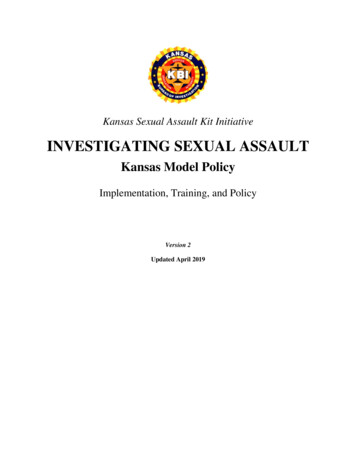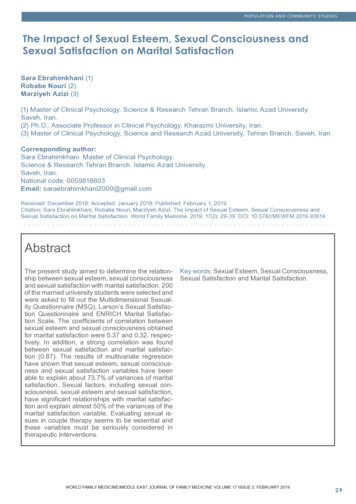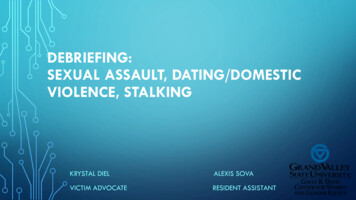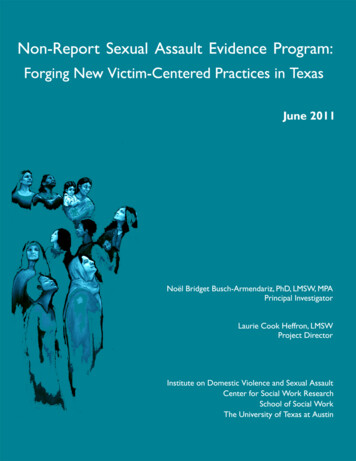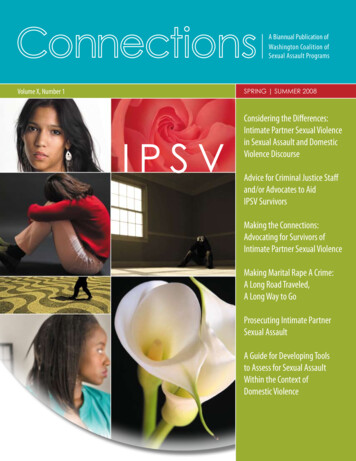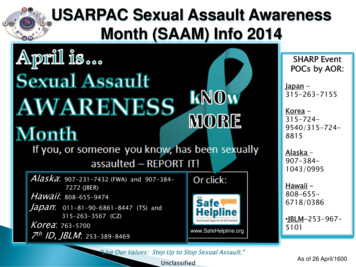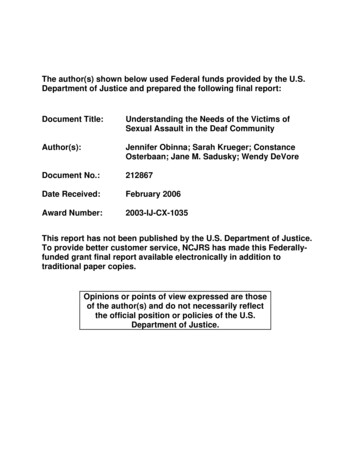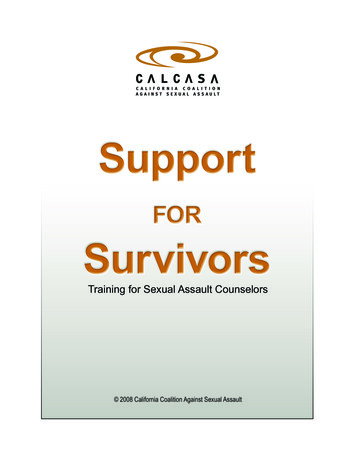
Transcription
Training for Sexual Assault Counselors 2008 California Coalition Against Sexual Assault1215 K Street, Suite 1100 Sacramento, CA 95814telephoneweb 166916.446.8802
This project was supported by Grant No. 2007-WF-AX-0054awarded by the Office on Violence Against Woman, U.S. Department of Justice, and throughGrant Award No. TE07101578 from the California Governor’s Office of Emergency Services(OES). Points of view, opinions, findings and conclusions in this publication are those of theauthor and do not necessarily represent the official position or policies of the U.S. Departmentof Justice or OES. OES reserves a royalty-free, nonexclusive, and irrevocable licenses toreproduce, publish, and use these materials and to authorize others to do so.3
Table of ContentsIntroduction . . . . . . . . . . . . . . . . . . . . . . . . . . . . . . . . . . 7Chapter 1 Violence Against Women . . . . . . . . . . . . . 11Chapter 2 Sexual Assault . . . . . . . . . . . . . . . . . . . . . . 17Chapter 3 Crisis Intervention . . . . . . . . . . . . . . . . . . . 23Chapter 4 Cultural Awareness . . . . . . . . . . . . . . . . . . 29Oppression and VictimizationSurvivors in the MilitarySurvivors Behind BarsChapter 5 Medical and Legal Systems . . . . . . . . . . . 51Medical & Legal Systems/Systems AdvocacyThe Workplace Rights of Sexual Assault SurvivorsChapter 6 Employment Law . . . . . . . . . . . . . . . . . . . . 63Chapter 7 Continued Healing . . . . . . . . . . . . . . . . . . . 69Appendix . . . . . . . . . . . . . . . . . . . . . . . . . . . . . . . . . . . . .Index . . . . . . . . . . . . . . . . . . . . . . . . . . . . . . . . . . . . . . . .5
IntroductionAn estimated 302,100 women and 92,700 men are forcibly raped each year inthe United States (Tjaden and Thoennes, 2000)1.Sexual assault is a problem of sweeping proportions in California and acrossthe nation.Welcome to CALCASA’s Support for Survivors Guide. Thank you forjoining with us to end sexual violence. Serving survivors is a critical part of ourwork, and we are honored to have you join us. As you embark on this journeyto learn more about sexual violence, how to advocate and support survivors,and what you can do to end sexual violence in your community, we are hopefulthat this guide can provide you with important resources along the way.CALCASA is proud to support the journey of so many counselors. Thisguide was originally produced in 1999, thanks to the many friends, supporters,and colleagues who wrote the original pieces contained within it. Thesearticles are still useful today, nearly 10 years after they were written, to supportanother decade of folks coming up through trainings across the state andacross the country. Where we are in the field now is different from where wewere 10 years ago; though these articles are still important and relevant, thecontext in which we’re operating as rape crisis centers and coalitions is inmany ways quite different.In order to provide some information about that context to you as youread these articles, we’ve written introductory pieces to support the individualarticles within each section of this guide. These section introductions areintended to explain the themes of the sections, help you understand why theyare relevant to today’s rape crisis centers and counselors, and to help youunderstand the philosophical approach CALCASA supports relative to sexualassault counseling and advocacy. It is our hope that this guide will give you thetools you need to be an effective counselor, but also that it will help connectyou to the larger anti-rape movement and to the philosophy upon whichCALCASA bases its work.Sexual Violence (from CALCASA’s Strategic Vision Report)The American Medical Association (1995) has called sexual assault the “silent,violent epidemic.”2 For the individual victim, rape and other forms of sexualviolence are the degradation of the soul. For society as a whole, however,rape is the degradation of the human race. Sexual assault contributes to thedeterioration of community well-being and impacts everyone. This traumaticcrime, all too often accepted in American culture, affects women, men,children, families, economic progress, and our national pride.Sexual assault exists as a continuum of violence that includes theexploitation of women and girls; sexual harassment; molestation; incest; rapeCALCASA Support For Survivors Introduction7
of children; and rape by dates, acquaintances, spouses, significant others,and strangers. Sexual violence permeates our society; it can be found inour families and our marriages, throughout the media and the workplace, onschool yards and college campuses, and in collective attitudes that blame thevictim and excuse the perpetrator. Sexual assault has demonstrated links toother forms of violence such as gang violence, domestic violence and violencerelated to drug and alcohol use. Rape occurs routinely in prison life andremains a despicable, yet universal, aspectof war.Sexual violence represents the ultimate wielding of power and control.It constitutes a violation of a sacred place that is the intimate, soulful core ofthe self. So long as sexual violence exists and little girls grow up in fear, rapewill continue to limit the freedom of women and profoundly divide women andmen. Putting an end to rape will mean the beginning of the end for all forms ofoppression.About this manualJust as it is importantto understand thefactors that makeup the uniqueexperience of eachindividual survivor, itis also important tounderstand the culturaldynamics and attitudesthat perpetuatesexual violence.The contents of the manual are set up to provide you with a narrativebackground on topics that are critical to sexual assault counseling andadvocacy.The manual is broken up into six sections: Violence Against Women,Sexual Assault, Crisis Intervention, Medical and Legal Systems, andContinued Healing. These sections take the reader through the backgroundand root causes of all forms of violence against women, to the specificphenomenon of sexual assault and its impact on individual victims. Thesections on the service systems (e.g. criminal legal, medical) and continuedhealing provide specific information about how counselors can support andadvocate for survivors at any point in their recovery processes. There areresources and tools in all of these sections to build your skills to work with anysurvivor, at any time.CALCASAWe Are The CaliforniaCoalition AgainstSexual Assault, astatewide coalitionof rape crisis centers and preventionprograms foundedin 1980.8Our Mission The CaliforniaCoalition AgainstSexual Assaultprovides leadership, vision andresourcesto rape crisis centers, individualsand other entitiescommitted to ending sexualviolence.Our Vision A world free fromsexual violence.CALCASA Support For Survivors Introduction
The California Coalition Against Sexual Assault (CALCASA) providesthe unifying vision and voice to all Californians speaking out against sexualviolence. CALCASA’s leadership at both the state and national level bringssupport, justice, and hope to victim/survivors of sexual assault, and to thosewho work to eradicate this pervasive problem in our communities. The needsof sexual violence victim/survivors as well as the prevention approachesdesigned to stop sexual assault, guide CALCASA as it works to impact publicpolicy, educate the public, and provide resources to all those working to endsexual violenceFounded in 1980, CALCASA is the only statewide organization inCalifornia whose sole purpose is to promote public policy, advocacy, trainingand technical assistance on the issue of sexual assault. CALCASA’s primarymembership is the 92 rape crisis centers and rape prevention programsin the state. CALCASA affiliate membership category is for organizations,businesses, individuals and others committed to our mission and our vision ofthe elimination of sexual violence.CALCASA works closely with rape crisis centers, governmentagencies, campuses, institutions, lawmakers, the criminal justice system,medical personnel, community-based organizations and business leadersproviding a central resource for improving society’s response to sexualviolence by supplying knowledge and expertise on a wide range of issues.References1. American Medical Association. (1995). Stratagies for the treatmentand prevention of sexual assault. Washington, DC: Americaan MedicalAssociation.2. Tjaden P, Thoennes N. (2000). Full report of the prevalence, incidence,and consequences of violence againse women: findings from the national violence against women survey. (Report for grant 93-IJ-CX-0012,funded by the National Institute of Justice and the Centers for DiseaseControl and Prevention). Washington, D.C.: National Institute of Justice.CALCASA Support For Survivors Introduction9
10
1ViolenceAgainst Women11
12CALCASA Support For Survivors Violence Against Women
Violence Against WomenAs you begin to read this manual, you’ll be oriented to the broad topicof violence against women. Rape and sexual violence are of coursespecific kinds of violence against women, but rape and sexual violenceare also types of violence used against children and men. Sexual violencesits in a place in our society that’s in the middle of a number of other forces;it’s a byproduct of a society that values women; people of color; people withdisabilities; children; people who are gay, lesbian, bi-sexual; people whoare transgender; and people from other marginalized groups all less than itvalues people from dominant social groups. And as a result of its reinforcingthe notion that some people are more valuable than others, generation aftergeneration, sexual violence has become one of the ways of people in power(positional, social, familial) maintain control over people who have less.Now, certainly this analysis is political in nature. In fact, the term “violenceagainst women” comes from federal legislation that was originally passed in1994, the Violence Against Women Act (VAWA). VAWA has been valuable toour work, though the limitations of the terminology have in some ways shapedour practice. The words “violence against women” do not begin to capture thefull breadth and depth of the multitudinous forms of violence intended underthat umbrella; after all, there is no one form of violence that only impactswomen. Certainly women are more often victimized by sexual assault,domestic violence, and stalking than men are, but children are frequentlyvictimized and this term leaves them out of the discussion altogether. Theterm “violence against women” captures a piece of our discussion in theanti-rape movement, but the phrase itself, the three words we use, are terriblyinadequate to express the nature, consequences, and impact of sexualviolence has had on multitudes of survivors.There are a number ofsocietal and culturalfactors that allowoffenders to perpetrateviolence againstwomen without beingheld accountable,and it’s critical tounderstand what helpssupport this cultureas you begin to workwith survivors andto support sexualviolence prevention.The political nature of violence against women may not be the first thoughtthat comes into our mind when we read about rape or sexual assault. After all,we’ve been taught to worry about “stranger in the bushes” and that there isn’tmuch more to consider regarding rape than our own personal safety (hencethe push for self-defense classes, safety call boxes, etc). However, statisticallywe know that the “stranger in the bushes” isn’t the one who’s most likely tocommit these acts. As we learn in the myths and facts section, assailants aremost likely to be someone whom we know and trust.If we understand that people we know and trust are the ones who rape,then we must ask ourselves what is it that leads them to do so? It would beeasy to think that assailants are driven by an uncontrollable desire for sex,but we know that that isn’t true either. In fact, rapists often have consenting,monogamous sexual partners. In fact, men (and women) can control theirsexuality. Rape is absolutely an intentional act. So why rape?As this section explains what the broad term “violence against women”represents it also establishes why such violence exists in our society.The various forms of violence against women are often broken down intothree main categories: domestic violence, sexual assault, and stalking. AndCALCASA Support For Survivors Violence Against Women13
within these categories there are many different types of violence, which willbe explained more on the following pages. Women and men can both bevictims of any of these crimes, but women are more frequently victimized(insert stat) so therefore they are considered violence against women.Violence committed against children is often addressed as child abuse, butsexual violence against children looks a lot more like rape against women, andthose two things are tied together statistically as well (women who were firstabused as children are more likely to be raped as adults). The intersectionsare complicated, but important to understand to fully comprehend the scope ofsexual violence in our society.The phenomenon of rape is triggered by an individual behavior, but itis bigger than that. It is a result of larger forces within our culture, such assexism, racism, homophobia, ablebodyism, classism, to name a few. Togetherthese “isms,” this set of cultural values and dynamics, creates an environmentthat allows rape to thrive and allows perpetrators to avoid accountability.Is rape inevitable? In this her article “Rape Culture,” Gillian Greensitebrings to our attention that there were times in history when men and womenlived in harmony. Anthropological Indicators imply that their culture was onewith no aggression and no war (page xx) which helps support the idea thatviolence is not a given among humans. In fact, it is possible for us to create asociety that does not use violence (and that can be our goal in our work). Weare reminded that it is not only our goal to reduce the rates of rape, but in factour goal is to eliminate rape in its entirely because it is within our control to doso. That is a powerful start to our work.As sexual assaultcounselors, we area part of a largermovement to endsexual violence,and our work eachindividual client isinformed by the legacyof the counselors,advocates, leaders,and educators whowent before us.Dismantling the culture that supports rape requires that we work on manydifferent fronts, from providing front line support to victims and survivors, todeveloping violence prevention initiatives, to working together to eliminateoppression in all of its forms. We are a movement dedicated to servingsurvivors, their friends, and their families, but we are also a movement drivento eliminate sexual violence from all communities, everywhere.As Greensite says in her article “History of the Rape Crisis Movement,” “aknowledge of the history of this movement will help you deal.with the everpresent outrage.An awareness that you are part of a movement will connectyou with a broader perspective and will challenge you to keep the movementalive.” (page xx) We must understand how brave our foremothers were, andhow many different voices with different experiences, and from vastly differentbackgrounds, have spoken out about rape over time. Our ability as advocatesand counselors to work in partnership with so many folks is as a direct result ofthe hard work of those who went before us, those who had to fight to be takenseriously, and those who had to be brave in the face of adversity. And for all ofthe ground they and we have covered, there are still miles to go before we’rethough.In the past fifteen years, we’ve addressed a number of issues asthey’ve emerged. Rape has been brought into the public policy arena, we’veexpanded our understanding of what sexual violence is (to include sexualharassment, for example), we’ve built multiple levels of prevention work, andcontinue to learn about the full range of ways sexual violence impacts thelives of survivors. We’ve learned that our solutions and remedies can not benarrowly focused on one system or set of systems (e.g, criminal legal system,health care) but instead we should focus our solutions on every facet of our14CALCASA Support For Survivors Violence Against Women
Believing that rape isnot inevitable givesus hope that wecan share with thesurvivors we meet. Partof our legacy in theanti-sexual violencemovement is to sharethat hope.society - because, as sexual violence is a trauma that impacts the survivor’sbody, mind, and soul, so too are the remedies survivors seek. Our legalremedies continue to grow, but we must also grow other systems as well.We’re continuing to add new dimensions to our work, such as buildinga collaborative approach to sex offender management, supporting victimsof sex trafficking, supporting services by and for marginalized communities,examining the intersections of health issues and sexual assault history, andothers. There aren’t easy answers for us as we build new solutions, and wemay disagree and debate what those solutions are. No matter the debatesand disagreements among us, it’s absolutely critical that we continue to pushourselves to find solutions that work for everyone.By developing our understanding of sexual violence and the peoplewho have worked for so long to end it, we are opening up avenues to figurehow to end the violence once and for all. Survivors deserve they deservecounselors who are compassionate and caring, but who are also dedicated tounderstanding what brought them to us in the first place.CALCASA Support For Survivors Violence Against Women15
16
2Sexual Assault17
18CALCASA Support For Survivors Sexual Assault
CALCASA Support For SurvivorsSexual AssaultSexual AssaultUnderstanding the root causes of violence against women is a criticalUnderstanding the root causes of violence against women is a critical component of being acomponent of being a counselor for a sexual assault victim. However,counselor for a sexual assault victim. However, understanding violence against women doesunderstanding violence against women does not by itself preparenot by itself prepare you for thefull spectrum of behaviors and attitudes that make up theyouforthe violence.full spectrum of behaviors and attitudes that make up the specificspecific phenomenon of sexualphenomenon of sexual violence.Sexualviolenceof violenceagainstwomen,but isviolencenot a singlesubsetwithinandit.the fullcontinuumof sexualincludesbehaviorsSexual violenceis is a formInstead,Instead, the full continuumof sexualviolenceincludesbehaviors unwantedornot-agreed-tosexualconduct.a form of violenceunwanted or not-agreed-tosexualconduct.Becauseall formsof sexualviolenceareall formsof sexualviolenceare not onlyperpetratedagainstwomen- not onlyagainst teagainstchildrenandmenaswell- thereassailants perpetrate against children and men as well - there is also arange isisalsonot aasinglesubsetrangeof weexploretheof responses to the kinds of sexual violence. In this section, we explore thewithinit. of sexualvariousformsviolenceto beginto understandthetotypesof impactsit hasvariousformsandof sexualviolenceand to beginunderstandthe typesof onvictims.impacts it has on victims.Sexual violence ceAgainst Womensexual violence against adult womenSpecifically, the informationin this sectionwill give inyouinformationabout many of theSpecifically,the informationthisin-depthsection willgive you in-depthforms of sexual violence,including:information about many of the forms of sexual violence, including:-stranger rape,stranger rape,-date and acquaintance rape,-drug facilitated sexual assault, date and acquaintance rape,-child sexual abuse,-sexual harassment, drug facilitated sexual assault,-intimate partner sexual violence, and child sexual abuse,-same-sex sexual assault. sexual areharassment,Other forms of sexual violencenot included in this chapter, but should be recognized asforms of sexual violence that exist in our communities and may impact the survivors who seek intimate partner sexual violence, andour services. These include:-stalking, same-sex sexual assault.-sex trafficking,-genital mutilation,-forced participation in pornography,-forced prostitution, and-sexual slavery.CALCASA Support For Survivors Sexual Assault19
Other forms of sexual violence are not included in this chapter, but shouldbe recognized as forms of sexual violence that exist in our communities andmay impact the survivors who seek our services. These include: stalking, sex trafficking, genital mutilation, forced participation in pornography, forced prostitution, and sexual slavery.Additionally, there are environments in which assailants rape their victimsthat have distinct characteristics and dynamics that profoundly impactthe experience of victims, such as rape as a crime of war, rape inside themilitary, and prison rape. These topics warrant further discussion as well, andresources can be found at the end of this section.Understanding the range of behaviors that make up the spectrum of sexualviolence is important to help you see the depth and breadth of the problem ofsexual violence; it is also important to help you understand the specific typesof experiences the survivors whom you support have had. However, thoughthe circumstances and details about each type of sexual violence may bedistinct, it is critical to note that each type of victimization does not correspondto a specific impact or type of recovery for each victim. Though there are somegeneralities, the impact sexual violence has on its victims varies from victimto victim. The impact and consequences of the violence vary widely, but notnecessarily in direct relationship to the form the violence has taken.In other words, one victim might have a profound, intense response to arape while another victim may not - both reactions are normal, they are justdifferent reactions. Similarly, sexual harassment may have a profound impacton a specific victim but not on another. The type of violence does not affecteach victim in the same way - instead, each victim experiences violencethrough the lens of her own individual life experiences, and it’s important toknow that there is no ‘appropriate reaction’ to sexual assault. Each survivoryou work with at any point in her recovery may experience an entirely new setof emotions and/or reactions. Types of reactions and responses are discussedin this section and can help provide you with a framework to use to understandwhat each survivor you meet may be experiencing.Because we know that sexual violence does not happen in a vacuum, thatit is a result of set of cultural beliefs and attitudes supporting such violence(see introduction to the Violence Against Women section), we should note thateach survivor’s experience is also coming from her experience in this culturebefore the sexual violence happened to her. Each survivor’s experience isinformed by her experience in our society that condones sexist, heterosexist,racist, classist, able-bodyist attitudes and behavior, which may impact both herrecovery and her interest in seeking support services.Anne King and Jamie Lee Evans’ article on Same Sex Abuse challengesany analysis that holds that sexual violence is purely and act of misogyny.They state, “.it is vital to recognize that sexual violence is not just a20CALCASA Support For Survivors Sexual Assault
CALCASA Support For Survivorsphenomenon of male supremacy but is also used as a tool of control anddomination by women over other women and men over other men” (pagexx). They provide invaluable information about both woman-to-woman andmale-to-male sexual assault. They call for counselors to learn more aboutsame-sex sexual assault to develop more effective intervention and preventionstrategies. (For more information about the ways sexual violence impactsvictims from marginalized groups, see the section in this guide on CulturalAwareness.)As counselors weknow that there isno “one size fits all”approach to our work,so we remember thatit is the survivor whoguides in learningabout her experienceand providing her withthe support she needs.Though individual survivors experience differ, there are some generalitieswe can discuss regarding specific types of sexual violence. For example, thearticle “Child Sexual Abuse” discusses the specific dynamics that can affectsurvivors of childhood abuse. This piece describes the prevalence of childsexual abuse; characteristics of child sexual abuse experiences, includingincest and ritual abuse; later problems related to child sexual abuse; anddiscusses children’s experience of trauma. Though every child’s experience isunique, there is information in this article about how being abused as a childcan impact an adult survivor.Similarly, because we know that all survivors do not seek support andservices in the immediate aftermath of an assault, we can prepare ourselvesfor the range of needs survivors may have in the many years after theviolence. Because of this wide range in timing for seeking support services,counselors should be prepared to provide support at any point in a survivor’shealing process. The idea of long-term healing is clearly discussed in thearticle “Adult Survivors of Child Sexual Abuse.” This article also discussesthe fact that women and men who were sexually abused as children are atgreater risk for experiencing other forms of sexual violence as adults - anotherimportant topic for counselors to understand.There are countless ways sexual violence impacts survivors andcommunities, a few of which are outlined in the pages that follow. Mostimportantly, this section establishes the notion that there is a wide spectrum oftypes of sexual violence and a similarly wide range of reactions and responsesthat survivors each have. The dynamics of victimization are complex andmultifaceted, and can fill textbooks with analysis. Knowing that these dynamicsare complex can directly inform how we can support an individual survivorlooking for support.CALCASA Support For Survivors Sexual Assault21
22
3Crisis Intervention23
24CALCASA Support For Survivors Crisis Intervention
Crisis InterventionSurvivors who call our hotlines are often in a state of crisis. They mightbe in crisis for a variety of reasons, such as being in the immediateaftermath of an assault or by having experienced a triggering eventmany years after a rape. No matter the cause, survivors may look to us forhelp in managing and surviving while in a state of crisis.Sexual assault is a crime that impacts survivors on multiple levels. It’sa violation of the survivor’s body that also affects her emotional and evenspiritual well-being. As we learned in the previous section on Sexual Assault,the impacts of sexual violence can be far-reaching.As the survivor manages those multiple levels of impact, her usual copingsystem may not be sufficient to support her as it would without such an intenseand violent event. At those times, the survivor may be in a state of crisis.Crisis is defined by Lee Ann Hoff (as quoted in the first article within thissection) as “an acute emotional upset arising from situational, development,or social sources and resulting in a temporary inability to cope by means ofone’s usual problem-solving devices.” For a survivor of sexual violence, thecrisis could come from any number of sources, including the assault itself, atriggering episode, a flashback, or an external event related (or perhaps notrelated) to the assault itself - such as losing one’s job as a result of taking toomuch time off of work postassault.Counselors who work with survivors need to have the skills to providesupport and assistance during times of crisis. We use a crisis interventionmodel to guide our work as sexual assault counselors to support survivors toempower and connect them in a way that alleviates the crisis and supportstheir recovery. This section includes articles on the principles of crisisintervention, the techniques of crisis intervention, and the applications of crisisintervention.From the article “Principles of Crisis Intervention” by Annabel Prins andJosef Ruzek, here’s an explanation about we approach crisis interventionwork:In her influential book Trauma and Recovery, Judith Hermansuggests that the “core experiences of psychological trauma aredisempowerment and disconnection”. Disempowerment refers toa decreased sense of personal control or power over one’s lifeand environment. Disconnection refers to a sense of difference oralienation from others. Herman argues that the guiding principlesbehind all recovery efforts must therefore be reempowerment and theestablishment of new and meaningful relationships. Consequently,these are the two main goals of crisis intervention.CALCASA Support For Survivors Crisis Intervention25
Building yourcounseling tools takestime and practice, andthough this sectionis quite informativeabout what solid crisisintervention skillsare, it is necessary touse your news skillsand seek feedbackon your work in orderto improve yourtechniques.The following articles will help you understand the basis and application ofcrisis intervention theory. The articles provide detailed information about howto support survivors and how to hone your counseling skills.Crisis intervention skills are useful throughout your work with survivors.Crisis calls on the hotline certainly requ
Sexual Assault, Crisis Intervention, Medical and Legal Systems, and Continued Healing. These sections take the reader through the background and root causes of all forms of violence against women, to the specific phenomenon of
